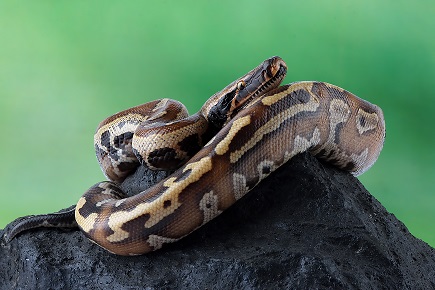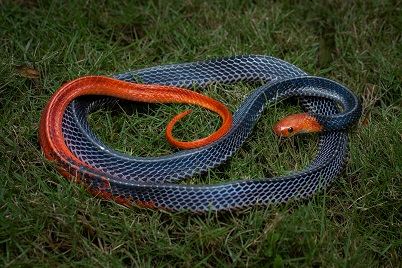May 20, 2024
Of all the animals found in Restorasi Ekosistem Riau (RER), few can strike fear into the hearts of people quite like snakes. But do these incredible reptiles really deserve their fearsome reputation? What characteristics do different species have in common, and what sets them apart? How do they hunt, and which is more dangerous?
In this article, we’ll investigate the taxonomy, appearance, and behavior of pythons and cobras, to uncover the important role they play in their ecosystem. Ready for some scintillating serpent facts? Let’s slither off in search of answers…
Taxonomy
Cobras are venomous snakes. Part of the Elapidae family, they can be found in a variety of habitats – from tropical rainforests to savannas and deserts in Africa, the Middle East, southern Asia and some islands of southeast Asia.
Pythons, on the other hand, are non-venomous snakes from the Pythonidae family. They are distributed around Asia, Africa, and Australia. Because they are not native to North or South America, pythons are considered Old World snakes.
Physical appearance
One quick and easy way to tell a cobra from a python is how they look. Pythons tend to be longer, thicker, and more colorful than cobras, and often feature intricate markings such as spots or bands. Python patterning is similar to the markings on a giraffe, whereas king cobras tend to be darker in color and have a chevron pattern on the back of their neck.
According to the Guinness Book of World Records, the longest python on record is a reticulated python that stretched a massive 25.2 feet in length. By comparison, the biggest known cobra was 19.2 feet long. One of the defining characteristics of a kind cobra is its flexible hood, which they flare out to scare away predators or intimidate their rivals. This distinctive hood is not found in any python species.
Speed
King cobras are some of the fastest snakes in the world, and can reach speeds of up to 12 mph. But that’s just their traveling speed. King cobras are considered one of the world’s deadliest snakes because of the speed at which their venom takes effect on prey. Once bitten, a human only has about 30 minutes to live. Given enough time, this venom can even bring down an adult bull elephant.
Pythons, on the other hand, are not very fast at all. Because they are typically ambush hunters, waiting in trees and bushes for unsuspecting prey, these snakes don’t need to move quickly. As a result, their top speed is a modest 1 mph. Much slower than a cobra, but if you were cornered by a big one in the jungle, no less deadly.
Cobras & Pythons: 5 Fun Facts
Attack abilities
Cobras kill their prey with a powerful venom, which it injects directly into the bloodstream with fangs that work like hypodermic needles. As a defense, some cobras can also spit their venom towards the eyes of their attacker, which can cause extreme pain and even blindness.
Pythons have a different approach. They prefer to lie in wait, using their coloration and markings as camouflage to help them blend in to their environment. When a potential meal walks past, they quickly spring out of their hiding place and wrap their coils around it, slowly squeezing their air out of its lungs until the animal dies of asphyxiation.

In terms of their danger to people, both cobras and pythons can be deadly, but in very different ways and for different reasons. If a cobra bites you, it’s usually in self-defense. Nevertheless, a cobra bite can be deadly – causing heart failure and lung paralysis within a matter of minutes. Pythons don’t have venom, but can be even more deadly than cobras. These are one of the few animals known to prey on people, particularly in remote rural areas, where the snakes can grow huge and catch wandering humans unawares.
Role in ecosystem
Both cobras and phytons are middle-order hunters, which gives them an essential role in their respective food webs. They feed on a wide range of species, especially rodents, which helps keep populations in check. In turn, they too can be preyed upon by other animals. This gives them a dual role in the ecosystem, both as predators and prey.
RER biodiversity
Pythons and cobras are included among the 106 reptiles and amphibians identified in RER in 2023, one of which – the king cobra – is considered Vulnerable (VU) by the International Union for Conservation of Nature (IUCN) Red List. In total, we’ve already observed four Elapidae species and two species from the Pythonidae family in RER. Some of the cobra spotted in RER include the red-headed crate (Bungarus flaviceps), blue coral snake (Calliophis bivirgata), Sumatran cobra (Naja sumatrana), and king cobra (Ophiophagus hannah). RER is also home to reticulated pythons (Malayopython reticulatus) and red short-tailed pythons (Python brongersmai).

Pythons and cobras are both deadly and beautiful creatures. With their combination of size, speed, venom, and constrictive power, both can potentially be dangerous to people. However, it is worth remembering that the vast majority of snakes would rather avoid people than tussle with them. Cobras will only strike when threatened, and only the very largest pythons will prey on people – attacks on humans are extremely rare. By comparison, humans are the number-one threat to all species of snakes, responsible for loss of habitat, predation, trapping, and killing for their skins.
In RER, pythons and cobras are able to live in relative peace. Surrounded by pristine peatland forests covering an area that’s roughly twice the size of Singapore, these animals can continue keeping the ecosystem in check, as they have done for millions of years.